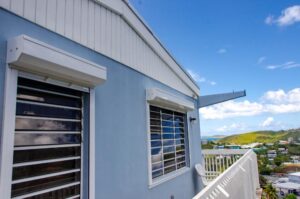
Before the water began to recede and the winds grew silent in 2017, one phrase stood out above the rest to symbolize recovery – “VI Strong.” This expression not only reflects the spirit of Virgin Islanders but also captures the recovery efforts over the past five years. Building “VI Strong” means using resources to not only rebuild what was lost but building back stronger and more resilient to protect against future disasters.
Coordination between FEMA and the territory, including the Office of Disaster Recovery and the Virgin Islands Territorial Emergency Management Agency, has led to the formation of many recovery and resilience projects. Projects include strengthening the power grid as well as hardening homes and critical infrastructure.
Wind retrofit projects are a major area of focus. FEMA and the territory continue to work together to minimize future damage. A wind retrofit includes specific renovations of a facility’s roof, windows and doors to increase its ability to withstand hurricane-force winds.
On St. Thomas, at the University of the Virgin Islands Orville E. Kean Campus, a $4.1 million wind retrofit project is in design specifically for student residential halls and the Ralph M. Paiewonsky Library. The retrofits of the buildings on the campus seek to reduce damage in future wind events and allow for the better protection of students, faculty and staff.
Throughout the territory, FEMA is also supporting wind retrofits in numerous housing communities. “We have large housing projects which will provide wind retrofit to various public housing complexes, 44 residential buildings and a community center,” said FEMA USVI Joint Recovery Office Hazard Mitigation Deputy Branch Director Sandra Lashley.
“We also have school safe room projects on St. Thomas, including the Charlotte Amalie High School, which is going to have a reconstructed sports arena to meet saferoom standards. That saferoom will provide space for 1,475 residents. We also have several drainage and generator projects, as well as additional wind retrofit projects for the island,” she said.
On St. John, the St. John Community Foundation Residential Wind Retrofit project proposes to harden 97 residences on the island to withstand at least a 100-year wind event. This $7 million project includes structural rebuilding or tie-downs of the roofs of residential homes. Other measures may include strengthening vents, soffits and overhangs at gable end walls; protecting building openings from wind-borne debris; bracing gable end walls, and strengthening the connections of attached structures.
“This wind retrofit project on St. John is a successful project that we can already see making a difference,” said Lashley.
The St. John Community Center safe room and building retrofit is a relatively new project that will reconstruct or retrofit the Center into a two-story facility and will incorporate a community safe room. A safe room is a hardened structure specifically designed to meet the FEMA criteria and provide 72-hour near-absolute protection in extreme wind events, including tornadoes and hurricanes.
Other projects on St. John include undergrounding of utility lines, the replacement of wooden utility poles with composite poles, a solar wind farm. and various drainage projects.
On St. Croix, a $129.7 million project will construct a 20-megawatt solar generation photovoltaic plant and a 20-megawatt battery energy storage system providing renewable energy to the territory while increasing the reliability of the power grid. This effort will provide parts of St. Croix with power during extreme weather events.
When water comes down hard and fast, good drainage can make the difference between complete isolation and access to life-saving food and water during a crisis. There are several drainage projects in the works, including Gallows Bay, La Reine Intersection and Estate Paradise Drainage. The Gallows Bay Drainage seeks to eliminate flooding and prevent additional damage to the road and sewage system that results from current flooding.
The La Reine Intersection Drainage includes the construction of a retention pond above the La Reine Intersection, which will alleviate the recurring flooding of the intersection, surrounding homes and businesses. The Estate Paradise Drainage improves and redirects the drainage of flood waters to reduce damages and prevent undue burdens on the residents of the area.
Recently, the territory broke ground for the Walter I.M. Hodge Pavilion housing community, which includes $25.3 million in funding for a wind retrofit project. Hodge Pavilion comprises 20 residential buildings, an office building and a community center. This facility will be renovated with hurricane wind-resistant windows and doors and provide continuous load protection by strapping the roof down to the foundation.
Other projects include wind retrofit for a number of properties, generator projects for various facilities, critical services facilities, as well as emergency safe rooms for first responders.
Two major safe room projects currently in the design phase are located at Central High School and Arthur Richards School. These projects will harden the reconstructed gymnasiums to meet safe room standards. The safe rooms can provide space for 938 residents at Central High School and 690 residents at the Arthur Richards School.
The VITEMA St. Croix Emergency Operations Center is also included as a $22.5 million wind retrofit and saferoom project.
On Water Island, there is a Water Island Firehouse Wind Retrofit project.
“It’s a wind retrofit project for a volunteer firehouse, which is also the main government building on Water Island and the center of communication for critical services,” said Lashley. “This project has nearly $34,000 for a wind retrofit.”
Rebuilding is more than restoring infrastructure back to pre-disaster conditions, it is laying the foundation for a more resilient Virgin Islands. Through mitigation initiatives, together, FEMA and the territory can lessen the impact of future disasters. FEMA is committed to ensuring all Virgin Islanders are “VI Strong.”





